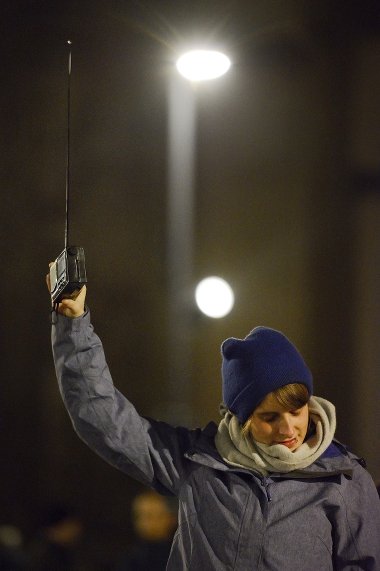Against our habits we use this last Kunstradio program of the year to look back on the highlights of radio art in 2016. We present the production “Desert Bloom” by Christina Kubisch, Florian Kindlinger and Peter Kutin, which was awarded the renowned Karl-Sczuka-Preis for radio art. And we look back on the festival Radio Revolten.
1) „Radio Unbroken – songspiel für radio revolten“
by Gregory Whitehead & Helen Hahmann
 PLAY
PLAY

Foto: Marcus-Andreas Mohr
Undoubtedly the most extensive and largest festival of its kind, Radio Revolten took place in October 2016 in the German city of Halle/Saale. It was coordinated by Radio Corax, and in charge of the coordination was Helen Hahmann. The musician and radio producer created a so-called songspiel, together with US-artist Gregory Whitehead.
“Radio Unbroken” fragments uses fragments from the radio art manifestoes collected at the festival.
“Radio Unbroken” is composed of three parts:
– Lover in Revolt
– The Future of Radio is Dirty
– Radio Unbroken
Link:
http://radiorevolten.net/fm-for-culture-20-kuenstler_innen-beginnen-ein-radio-manifest
2) Karl-Sczuka-Preis 2016: „Desert Bloom“
by Florian Kindlinger, Christina Kubisch and Peter Kutin
In 2016 the German broadcasting station Südwestfunk SWR awarded Christina Kubisch, Peter Kutin and Florian Kindlinger for their production „Desert Bloom“ with the renowned Karl-Sczuka-Preis for radio art. It was produced by the WDR and premiered in 2015 on „Studio Akustische Kunst“. „Desert Bloom“ is a trip on the acoustic backside of Las Vegas, listening beyond the glittery and shiny surface of the city. Underneath this surface the city consists of a dense grid of electromagnetic waves, producing a constant flickering and pulsating acoustic backdrop to the entertainment machinery of Las Vegas.
Kubisch recorded electromagnetic signals of various light sources all over the city, creating an archive of various electromagnetic-sounds that normally remain undetected by our auditive perception. Usually we only see light and don't think about it's sound. Kubisch uses extensions for her ears, specially developed headphones that translate electro-smog directly into audible signals. Later on Kutin arranged the piece in his studio in an orchestral manner. The city has been used as a big modluar-synthesizer, whose sounds are the foundation of this opulent work. Still the piece follows the trilogy's inherent documentary path, by again detecting a (hidden) layer of our reality and using it as material.”
Links:
Hoerspielkritik.de
SWR Karl-Sczuka-Preis
 PLAY
PLAY
